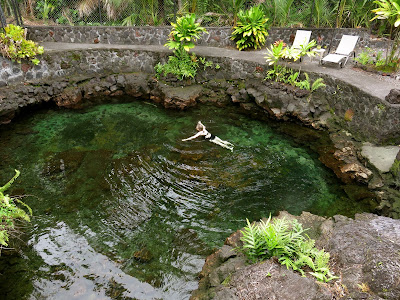Four months ago, on March 20, 2018, Tim and I walked into our rental house in Kapoho Vacationland on the Big Island of Hawaii.
"Feels like coming home," Tim said. Agreed.
The house, christened Punana Kiowai, provided rest and relaxation for three nights, a comfortable and welcome tropical refuge. A variety of outdoor living areas graced the premises, including a naturally lava-heated pool.
"Feels like coming home," Tim said. Agreed.
The house, christened Punana Kiowai, provided rest and relaxation for three nights, a comfortable and welcome tropical refuge. A variety of outdoor living areas graced the premises, including a naturally lava-heated pool.
But the best thing about this rental was its location, mere steps away from a significant marine conservation area, the Wai`opae Tide Pools. The Tide Pools formed when the ocean found its way into an ancient lava flow, creating a series of pools and passages populated by coral, sea creatures and tropical fish. Tim and I first discovered this area on a 2015 trip to the Big Island and I have returned three times since then, renting a total of four different homes in Kapoho near the spectacular Tide Pools.
We unpacked our bags, settled in, and the backyard pool beckoned.
“You know”, I said to Tim as I floated in the warm water, “lava-heated means there’s lava flowing underground, probably close by.”
We unpacked our bags, settled in, and the backyard pool beckoned.
 |
| These lava-heated pools were a common feature of many homes in Kapoho Vacationland. |
“You know”, I said to Tim as I floated in the warm water, “lava-heated means there’s lava flowing underground, probably close by.”
As it turned out, the phrase Naturally Lava-Heated Pool was indeed a warning. Nearby Kilauea Volcano was biding its time, lying in wait to reclaim the land.
And reclaim the land it did. By mid-June of 2018, our rental home, Punana Kiowai, as well as 320 other homes in Kapoho Vacationland, the Kapoho Bay, and the Wai`opae Tide Pools, lay buried under up to 20 feet of lava.
Kilauea, one of the most active volcanoes on earth, has been oozing lava for 35 years. This spring, pressure building in underground vents caused thousands of earthquakes, then massive amounts of lava spewed to the surface and bulldozed its way over the land.
What is lost:
 |
| Gone. This view of the Tide Pools from our 2015 rental home—Mika Lani, Jewel By the Sea—will never be seen again. 20 feet of lava now covers this home and the surrounding area. |
 |
| Four-spot Butterfly Fish swim and graze on the impressive coral in the Wai`opae Tide Pools. |
 |
| A Yellowtail Coris (bottom), Peacock Grouper, and Moorish Idols (top) swim in the tide pools in this photo from 2016. |
 |
| A pair of Ornate Butterfly Fish. I wonder if these two, and the fish in the preceding photographs, made it out to the open sea before lava filled the Tide Pools? |
Am I sad the Wai`opae Tide Pools no longer exist in our world? Oh yes, immeasurably so. But do I consider this an ecological disaster? No. This is simply a volcano being a volcano, doing what volcanoes do best: reminding us that we are not in charge.
I can't claim expertise about the geology of the Hawaiian Islands, but it seems possible that some day, maybe hundreds/thousands of years from now, tide pools may again form in the new lava along Hawaii’s eastern shore. And I have learned one important geological tenet:

6 comments:
My gosh, Rita! Scary to think you and Tim were there just before it all disappeared. How wonderful to get to see the Tide Pools before they vanished. And, yes, I’m with you that nature will find it’s way to reclaim the lava and bring it back to teeming life. (I had the same feeling in Santorini, which is the caldera left from a sea volcano, especially after touring the center and seeing hot steam escape from recently cooled rocks!) ��
Hi Vickie!
I learned something new from your comment. I didn't know that Santorini was volcanic in origin. How interesting that volcanic steam is still emanating from rocks there!
The natural world certainly is fascinating and I'm sure life will find its way back into the lava—whether we humans will still be around to see it though, well, I'm not so sure about that!
Good to hear from you. Thanks for commenting!
What an interesting blog posting, Rita!
It’s must surely be heartbreaking to know that you will never have the pleasure of experiencing the Tide Pools you described. However, I think you have adopted the right attitude. As you state, this was simply the result of “a volcano being a volcano”. It would be much more distressing if this had been an avoidable manmade-disaster, such as an oil-spill, etc, etc.
John
You're right, John—I'm in total agreement about the distressing nature of manmade disasters.
Catastrophes such as the BP oil spill (effects still being manifested) are so pointless, and many times are the result of greed and/or "cutting corners" on safety.
Thanks for reading and commenting!
What an absolutely charming post, Rita! One certainly cannot help but wonder, in the face of such momentous events and geography live!
Not to mention such beautiful pictures of the fish. Another wonder there. Only the other day, was watching the quaint sea sapphire on BBC which has somehow mastered the science of turning invisible to the eye which we, as humans, have not yet been able to do. And fish with such names as trunk fish, box fish, butterfly fish :)
Undersea creatures really are wondrous, aren't they? My hope is that most of the mobile sea creatures made it out of the tide pools before the lava hit. Unfortunately the coral, anemones, urchins, etc. are now buried.
But earth's natural geologic features are wondrous too!
Thanks for your comments, Soumyendu!
Post a Comment